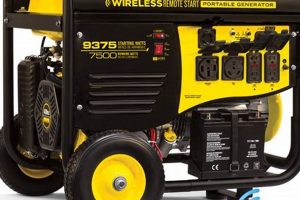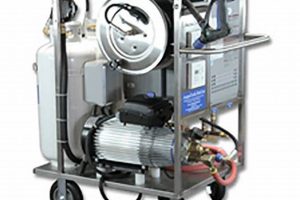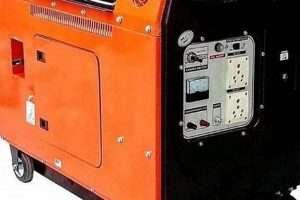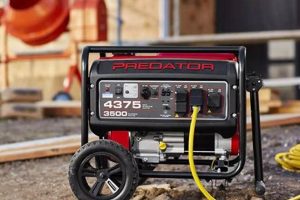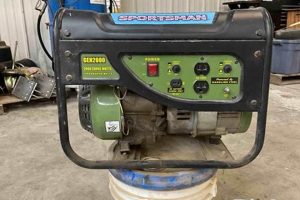Compact, mobile power sources offering a budget-friendly solution for temporary electricity needs represent a significant market segment. These units can power essential appliances during outages, provide electricity for outdoor activities, or serve as a backup power source for job sites. A homeowner might use one to operate a refrigerator and a few lights during a power outage, while a contractor might employ a similar unit to power tools on a remote construction site.
Access to affordable, mobile electricity enhances resilience in emergencies and facilitates activities beyond the reach of traditional power grids. Historically, accessing temporary power was often expensive and cumbersome. The increasing availability of smaller, more efficient, and less expensive generators has democratized access to backup power, benefiting homeowners, small businesses, and recreational users alike. This accessibility contributes to improved safety and productivity in various situations.
This article delves into the various aspects of acquiring budget-friendly mobile power sources. Topics include selecting the appropriate power output, understanding different fuel types, evaluating important features, and making informed purchasing decisions.
Tips for Acquiring Budget-Friendly Portable Generators
Careful consideration of several factors is crucial for procuring a suitable and cost-effective mobile power source. The following tips offer guidance for navigating the purchasing process.
Tip 1: Assess Power Needs: Determine the wattage required to operate the intended devices. Creating a list of appliances and their respective power consumption facilitates accurate generator sizing.
Tip 2: Evaluate Fuel Options: Gasoline, propane, and diesel models offer distinct advantages and disadvantages regarding fuel cost, availability, and storage requirements. Consider the practicalities of each fuel type based on individual circumstances.
Tip 3: Research Brands and Models: Compare specifications, features, and customer reviews from reputable manufacturers. Prioritizing reliability and durability ensures long-term value.
Tip 4: Explore Local Retailers and Online Marketplaces: Compare prices from different vendors, including brick-and-mortar stores and online platforms. Factor in shipping costs and warranty terms.
Tip 5: Consider Used Generators: A pre-owned unit can offer significant cost savings. However, thoroughly inspect used generators for signs of wear and tear and inquire about maintenance history.
Tip 6: Prioritize Safety Features: Essential safety features include automatic shut-off for low oil levels and overload protection. Never compromise on safety to save money.
Tip 7: Understand Warranty Coverage: A comprehensive warranty provides peace of mind and protects against unforeseen repairs. Carefully review the warranty terms before making a purchase.
Adhering to these guidelines will facilitate informed decision-making and increase the likelihood of acquiring a reliable, cost-effective mobile electricity source appropriate for individual needs.
By understanding power requirements, fuel options, available brands, and safety considerations, consumers can confidently navigate the market and make a purchase aligned with their budget and power needs. The next section provides concluding remarks and emphasizes the importance of responsible generator usage.
1. Power Output
Power output, measured in watts, represents a critical factor influencing the suitability of a portable generator for specific applications. Understanding power output requirements is essential for selecting a cost-effective generator capable of reliably powering the intended devices. Insufficient power output leads to overloaded circuits and potential damage to both the generator and connected appliances. Conversely, excessive power output translates to unnecessary fuel consumption and higher purchase costs.
- Starting vs. Running Watts
Electrical devices often require a surge of power upon startup, known as starting watts, which significantly exceeds the power needed for continuous operation (running watts). Generators must accommodate both. For instance, a refrigerator might require 2,000 starting watts but only 700 running watts. Overlooking this distinction can lead to an underpowered generator struggling to start appliances. Selecting a generator with sufficient starting wattage ensures reliable operation even during initial power surges.
- Wattage Requirements of Common Appliances
Different appliances have varying power demands. A small television might require only 100 watts, while a microwave oven could draw 1,000 watts or more. A sump pump might require 800 starting watts and 400 running watts. Compiling a comprehensive list of intended appliances and their respective power requirements enables accurate generator sizing. This informed approach avoids purchasing an underpowered or unnecessarily large generator.
- Matching Generator Capacity to Load
Accurately matching generator capacity to the anticipated load is vital for efficient and safe operation. Connecting a 1,500-watt space heater to a 1,000-watt generator risks overloading the generator and potentially causing damage. Calculating the total wattage required by all intended devices and selecting a generator with sufficient capacity prevents overloads and ensures reliable performance.
- Impact of Power Output on Price
Generally, higher power output correlates with higher generator cost. A 2,000-watt generator typically costs less than a 7,000-watt generator. Carefully assessing power needs and selecting a generator with appropriate output, without significant excess capacity, can lead to cost savings. This optimized approach avoids unnecessary expenditure on a larger, more expensive generator when a smaller unit would suffice.
Understanding the nuances of power output is crucial for acquiring a cost-effective portable generator capable of meeting specific power demands. By considering starting vs. running watts, appliance requirements, and matching generator capacity to load, consumers can make informed purchasing decisions, balancing performance and affordability. This knowledge also contributes to safe and efficient generator operation, preventing overloads and maximizing the lifespan of both the generator and connected devices.
2. Fuel Efficiency
Fuel efficiency plays a crucial role in the overall cost-effectiveness of a portable generator. While the initial purchase price is a significant factor, the ongoing cost of fuel can considerably impact long-term expenses. A less expensive generator with poor fuel efficiency might ultimately prove more costly than a slightly more expensive, fuel-efficient model. Understanding the factors influencing fuel efficiency empowers consumers to make informed purchasing decisions aligned with budget constraints and usage patterns.
- Fuel Consumption Rate
Generators consume fuel at varying rates, typically measured in gallons per hour (GPH) or liters per hour (LPH). A generator consuming 0.5 GPH will deplete fuel twice as fast as a comparable model consuming 0.25 GPH. This difference becomes significant during extended operation, impacting both fuel costs and the frequency of refueling. Manufacturers usually provide fuel consumption data in generator specifications.
- Runtime per Fuel Tank
Runtime, often specified at 25% or 50% load, indicates how long a generator can operate on a single tank of fuel. Longer runtimes translate to fewer refueling interruptions, especially critical during extended power outages or remote applications. Comparing runtime specifications across different models helps assess their relative fuel efficiency and suitability for specific needs. A larger fuel tank does not necessarily equate to longer runtime if the generator consumes fuel at a higher rate.
- Impact of Load on Fuel Consumption
Generators consume more fuel under heavier loads. Operating a generator at 25% of its rated capacity consumes significantly less fuel than operating it at 75% or 100% capacity. Understanding the relationship between load and fuel consumption helps optimize generator usage and minimize fuel costs. Matching generator capacity to actual power needs prevents unnecessary fuel expenditure from operating an oversized generator at a low load.
- Engine Technology and Fuel Efficiency
Inverter generators generally offer better fuel efficiency than conventional generators due to their variable engine speed. Inverter technology adjusts engine speed to match the load, reducing fuel consumption during periods of lower power demand. While often more expensive initially, inverter generators can provide long-term cost savings through reduced fuel usage, especially in scenarios with fluctuating power needs.
Fuel efficiency significantly impacts the long-term cost of owning and operating a portable generator. Carefully considering fuel consumption rate, runtime, load impact, and engine technology empowers consumers to select cost-effective generators that meet both power requirements and budgetary constraints. Prioritizing fuel efficiency contributes to lower operating costs and reduces the environmental impact associated with fuel consumption.
3. Budget Constraints
Budget constraints represent a primary consideration for consumers seeking portable generators. Balancing desired features and performance with affordability requires careful evaluation of various factors influencing the overall cost, including initial purchase price, operating expenses, and potential maintenance costs. Understanding the interplay between budget limitations and generator options empowers consumers to make informed decisions and maximize value.
- Initial Purchase Price
Generator prices vary significantly based on power output, features, brand reputation, and fuel type. Higher wattage generators typically command higher prices. Similarly, generators equipped with advanced features, such as inverter technology or electric start, often come at a premium. Established brands known for reliability and durability might also have higher price points. Consumers operating within tight budget constraints might prioritize essential features and power output over premium options or brand recognition.
- Operating Costs (Fuel)
Fuel consumption represents a significant ongoing expense associated with generator ownership. Generators with higher fuel efficiency consume less fuel for a given load, resulting in lower operating costs over time. Fuel prices fluctuate, influencing the long-term affordability of different fuel types. Consumers sensitive to operating costs might prioritize fuel-efficient models, even if the initial purchase price is slightly higher, to minimize long-term fuel expenditure. Choosing a generator with a fuel type readily available and affordable in their region further optimizes operating costs.
- Maintenance Costs
Regular maintenance, including oil changes, air filter replacements, and spark plug replacements, is essential for ensuring the longevity and reliable performance of a portable generator. Maintenance costs vary depending on the generator model and the complexity of maintenance procedures. Consumers on a budget might consider generators with simpler maintenance requirements and readily available parts to minimize potential repair expenses. Researching the typical maintenance schedule and associated costs before purchase allows for informed budgeting and avoids unexpected expenses.
- Balancing Features and Affordability
Budget limitations often necessitate trade-offs between desired features and overall affordability. Consumers might prioritize essential features, such as sufficient power output and reliable engine performance, over less critical features like electric start or multiple outlets. Opting for a basic model without non-essential features can significantly reduce the purchase price while still providing adequate functionality. Prioritizing needs and carefully evaluating the value proposition of different features empowers consumers to make informed decisions aligned with their budget.
Budget constraints significantly influence the selection of a portable generator. Carefully considering the initial purchase price, operating costs associated with fuel consumption, and potential maintenance expenses allows consumers to make informed decisions that balance functionality, performance, and affordability. Prioritizing essential features and power requirements while remaining mindful of long-term operating costs ensures the chosen generator meets both immediate needs and long-term budgetary constraints.
4. Safety Features
Safety features are paramount when considering portable generators, especially within the context of budget-conscious purchases. While cost remains a factor, compromising safety for affordability presents significant risks. Generators, by nature, produce electricity and exhaust fumes, posing potential hazards like fire, electrocution, and carbon monoxide poisoning. Prioritizing essential safety features mitigates these risks, ensuring user well-being and preventing property damage. For instance, a generator lacking a low-oil shutdown could seize due to insufficient lubrication, causing irreparable damage and potential fire hazards. Similarly, neglecting proper grounding increases the risk of electrocution. Choosing a generator equipped with essential safety mechanisms, even within a limited budget, ultimately contributes to a safer operating environment.
Several key safety features warrant careful consideration. Overload protection prevents damage to the generator and connected devices by automatically shutting down the generator when the electrical load exceeds its capacity. This feature is crucial, especially in budget-oriented scenarios where users might be tempted to overload a smaller, less expensive generator. A low-oil shutdown safeguards the engine from damage by automatically turning off the generator when oil levels drop below a critical threshold. This prevents costly repairs and extends the generator’s lifespan. Proper grounding prevents electrical shocks by providing a path for stray current to flow safely into the earth. A GFCI (Ground Fault Circuit Interrupter) outlet offers additional protection against electrocution by quickly shutting off power in the event of a ground fault.
Prioritizing safety features, even with budget constraints, remains crucial for responsible generator ownership. While less expensive models might lack some advanced safety mechanisms, ensuring the presence of fundamental safety features like overload protection, low-oil shutdown, and proper grounding remains non-negotiable. Understanding the implications of compromising on safety features empowers consumers to make informed purchasing decisions aligned with both budgetary limitations and essential safety requirements. This informed approach minimizes potential risks and ensures safe generator operation, ultimately protecting users, property, and connected devices.
5. Noise Levels
Noise levels represent a critical consideration when selecting a portable generator, particularly within the context of budget constraints. While affordability often drives purchasing decisions, overlooking noise output can lead to significant disruptions and neighborhood disturbances. Balancing cost with acceptable noise levels requires careful evaluation of generator specifications and potential operating environments. Excessive noise can not only disrupt personal comfort but also lead to conflicts with neighbors or violate local noise ordinances. Understanding the relationship between noise output, generator technology, and price empowers consumers to make informed decisions aligned with both budgetary limitations and noise sensitivity.
- Decibel Ratings and Their Significance
Generator noise levels, typically measured in decibels (dB), provide a quantifiable measure of sound intensity. Higher dB values indicate louder operation. A difference of 10 dB represents a tenfold increase in perceived loudness. A 70 dB generator, for example, produces sound roughly twice as loud as a 60 dB generator. Manufacturers often specify noise levels at a particular distance, such as 23 feet (7 meters). Comparing dB ratings across different models allows for an objective assessment of their relative noise output. This information is crucial for selecting a generator with acceptable noise levels for the intended operating environment, whether it’s a quiet campsite or a bustling construction site. Generators marketed as “quiet” typically operate within the 50-60 dB range, comparable to normal conversation.
- Impact of Generator Technology on Noise
Inverter generators generally produce less noise than conventional generators. Their variable engine speed adjusts to match the load, reducing noise output during periods of lower power demand. Conventional generators, on the other hand, operate at a fixed speed, often resulting in higher and more consistent noise levels regardless of the load. While inverter generators frequently come at a higher price point, their quieter operation can be a worthwhile investment, especially in noise-sensitive environments. This technology represents a significant advancement in noise reduction within portable power generation.
- Enclosure Design and Noise Reduction
Some generators feature enclosures specifically designed to dampen noise output. These enclosures effectively muffle engine noise and exhaust, resulting in quieter operation. However, enclosures can add to the generator’s size and weight, potentially impacting portability. Budget-friendly generators might lack advanced enclosure designs, making noise levels a more prominent consideration. Evaluating the trade-offs between noise reduction, portability, and cost enables consumers to prioritize features aligned with their specific needs.
- Operating Environment and Noise Considerations
The surrounding environment significantly influences the perceived impact of generator noise. Operating a generator in a densely populated area necessitates lower noise levels to minimize disturbance to neighbors. Conversely, noise considerations might be less critical in remote locations or industrial settings. Local noise ordinances often dictate permissible noise levels, particularly during specific hours. Understanding the operating environment and relevant regulations helps ensure compliance and minimizes potential noise-related conflicts. This awareness is essential for responsible generator usage.
Noise levels represent a crucial factor influencing generator selection, particularly within budget constraints. Balancing affordability with acceptable noise output requires careful consideration of decibel ratings, generator technology, enclosure design, and the intended operating environment. Prioritizing quieter operation, even within a limited budget, contributes to a more peaceful and considerate operating experience, minimizing disruptions and promoting harmonious coexistence with surrounding communities.
6. Portability
Portability represents a defining characteristic of these generators, directly influencing their suitability for various applications. The ease with which a generator can be transported and maneuvered significantly impacts its practicality and overall value. Understanding the factors contributing to portability empowers consumers to select models aligned with their specific needs and physical capabilities. Weight, dimensions, and integrated handling features all play a crucial role in determining a generator’s portability.
- Weight
Weight significantly impacts portability. Lighter generators are easier to transport and maneuver, especially across uneven terrain or in situations requiring frequent relocation. Heavier generators, while potentially offering higher power output, might necessitate assistance or specialized equipment for transport. Manufacturers typically specify dry weight, which excludes fuel and oil. Considering the added weight of fuel and oil provides a more realistic assessment of the total weight and its implications for portability. For instance, a generator weighing 50 pounds might be easily manageable for one person, while a 200-pound generator could require two people or a wheeled cart for transport. This distinction is crucial, especially for applications requiring frequent movement.
- Dimensions
Physical dimensions, including length, width, and height, influence storage and transportation requirements. Compact generators occupy less space, facilitating storage in vehicles, sheds, or limited storage areas. Larger generators, while potentially offering higher power output or longer runtimes, might present challenges for transport and storage. Evaluating dimensions in conjunction with weight provides a comprehensive understanding of a generator’s overall portability. A compact and lightweight generator offers maximum portability, while a bulky and heavy generator sacrifices portability for potentially increased power capacity. This trade-off necessitates careful consideration based on individual needs and logistical constraints.
- Integrated Handling Features
Features like built-in wheels, folding handles, and ergonomic lifting points enhance portability. Wheeled generators, for example, allow for easy rolling across flat surfaces, reducing strain during transport. Folding handles and ergonomic lifting points facilitate lifting and maneuvering, particularly in confined spaces. These features, while potentially adding to the generator’s cost, significantly enhance portability and ease of use. Budget-conscious consumers might prioritize these features if portability is a primary concern, as they minimize physical strain and facilitate transport. The presence of these features can be a deciding factor for individuals with limited physical strength or those frequently transporting the generator across varying terrains.
- Portability vs. Power Output
A trade-off often exists between portability and power output. Smaller, more portable generators typically offer lower power output, while larger, higher-output generators often sacrifice portability. Balancing power requirements with portability needs is crucial for selecting a suitable generator. Applications requiring high power output and frequent relocation might necessitate a compromise, potentially opting for a moderately sized generator with adequate power and acceptable portability. Carefully evaluating power needs and portability requirements allows for informed decision-making, ensuring the chosen generator meets both power demands and logistical constraints. This balance optimizes the generator’s utility and value.
Portability significantly impacts the practicality and overall value of a portable generator, particularly for budget-conscious consumers. Balancing weight, dimensions, and integrated handling features with affordability and power requirements empowers consumers to select models aligned with their specific needs and physical capabilities. Prioritizing portability enhances the generator’s usability and ensures ease of transport and storage, maximizing its utility across various applications.
Frequently Asked Questions
This section addresses common inquiries regarding the acquisition of budget-friendly portable generators.
Question 1: What is the typical lifespan of a portable generator?
Lifespan varies depending on usage, maintenance, and generator quality. Regular maintenance and proper storage can significantly extend lifespan, potentially exceeding 10 years. Neglecting maintenance can shorten lifespan considerably.
Question 2: How frequently should a portable generator require maintenance?
Maintenance schedules vary by model and manufacturer. However, regular oil changes, air filter cleaning or replacement, and spark plug replacement are essential. Consulting the owner’s manual provides specific maintenance intervals and procedures.
Question 3: What are the primary considerations when choosing between gasoline, propane, and inverter generators?
Gasoline generators offer wide availability and generally lower purchase prices, but require more frequent maintenance. Propane generators offer cleaner emissions and longer fuel storage life. Inverter generators prioritize fuel efficiency and quiet operation, typically at a higher initial cost.
Question 4: How is generator power output calculated and what does it signify?
Power output, measured in watts, indicates the amount of electricity a generator can produce. Starting watts represent the initial surge of power required to start appliances, while running watts indicate the power needed for continuous operation. Calculating total power requirements for intended devices ensures the generator can handle the load.
Question 5: Where can one find reliable sources for purchasing budget-friendly portable generators?
Reputable online retailers, local hardware stores, and authorized dealers offer reliable sources for purchasing generators. Comparing prices, warranty terms, and customer reviews across multiple vendors facilitates informed purchasing decisions.
Question 6: What safety precautions are essential when operating a portable generator?
Operating generators outdoors in well-ventilated areas is crucial to prevent carbon monoxide poisoning. Proper grounding protects against electrocution. Avoiding overloading the generator prevents damage and ensures safe operation. Consulting the owner’s manual provides comprehensive safety guidelines.
Careful consideration of these frequently asked questions empowers consumers to make informed decisions regarding the acquisition and operation of budget-friendly portable generators. Prioritizing safety, maintenance, and appropriate generator selection ensures reliable performance and long-term value.
This concludes the FAQ section. The following section provides concluding remarks and summarizes key takeaways for acquiring a cost-effective and reliable portable generator.
Conclusion
Acquiring suitable and cost-effective portable generators requires careful consideration of several interconnected factors. Balancing power requirements with budget constraints necessitates evaluating power output, fuel efficiency, and available features. Prioritizing safety features, even within a limited budget, remains paramount for responsible generator ownership. Noise levels and portability further influence generator suitability for specific applications and operating environments. Informed purchasing decisions stem from a comprehensive understanding of these elements, ensuring the chosen generator aligns with individual needs and budgetary limitations. Thorough research, comparison shopping, and careful consideration of long-term operating costs contribute to acquiring a reliable and valuable power source.
Access to reliable and affordable portable power sources enhances resilience and facilitates activities beyond the reach of traditional power grids. Careful consideration of the factors outlined herein empowers consumers to navigate the market effectively and make informed purchasing decisions. This informed approach ensures the acquisition of a valuable asset capable of providing essential power during outages, supporting outdoor activities, and enhancing productivity in various settings. The ability to access portable power affordably represents a significant advancement, contributing to increased preparedness, improved safety, and enhanced operational capabilities across diverse sectors.

